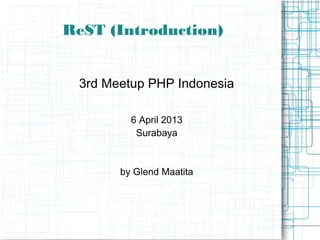PHP Indonesia 3rd meetup - 06/04/13
- 1. ReST (Introduction) 3rd Meetup PHP Indonesia 6 April 2013 Surabaya by Glend Maatita
- 4. ReST - History ˇń Representational State Transfer ˇń ReST was re-DISCOVER-ed by Roy Fielding ˇń Doesnt require any external library ˇń Tightly bond with HTTP
- 5. ReST ¨C HTTP Client Send Request Server Send Response GET / HTTP/1.1 Host: xkcd.com HTTP/1.1 200 OK Accept: text/html Date: Sat, 02 Apr 2011 21:05:05 GMT User-Agent: Mozilla/5.0 Server: lighttpd/1.4.19 (Macintosh) Content-Type: text/html <html>...</html>
- 6. ReST - HTTP HTTP Verb ˇń GET ˇń POST ˇń PUT ˇń DELETE Routes ˇń URL + HTTP Verb
- 7. ReST - Definition ˇ°The Same Thing with a different STATE changes its meaningˇ± ˇ°The message is changed based on it's Stateˇ±
- 8. ReST ¨C How To ˇń Loved by developer ˇń Easy to read, easy to understand, easy to learn
- 9. ReST Bad !! Imagine :) /getAllUsers /getMentions /getUserById /getUserTimeLine /getUsers /getHomeTimeLine /deleteUser /getStatusesRetweet /updateUser /updateStatuses /deleteUserTenYearsOld /destroyStatus /newUser /getRetweets /getUserUnderTenYearsOld
- 10. ReST - Quotes ˇ°Web it's not about HTML pages, it's about resources, and those resources are located by URLsˇ±
- 11. So ? ˇń We only need two base URLs as the location of a resource (collection of resource, and single resource) ˇń Resources is Noun, use Noun :) ˇń Plural is better Resource POST GET (READ) PUT DELETE (CREATE) (UPDATE) /users Create new List all Users Update All Delete All user Users Users /users/1 - Show User Update User Delete User (with ID = 1) with ID = 1 (if with ID = 1 Exist)
- 12. Association ? Easy :) GET /departments/1/users POST /departments/1/users PUT /users/123 DELETE /users/123
- 13. Query Use '?' for Query GET /users?limit=50&offset=100 GET /users?username=indra&birth=1990 GET /users?column=id,name,username,birth GET /users.json (/users.xml)
- 15. Terima Kasih Glend Maatita @glend_maatita YM : the_entung glend.maatita@kampus.co.id















